Books
Books

Blackspace: On the Poetics of an Afrofuture
Black artists of the avant-garde have always defined the future.
Blackspace: On the Poetics of an Afrofuture is the culmination of six years of multidisciplinary research by trans poet and curator Anaïs Duplan about the aesthetic strategies used by experimental artists of color since the 1960s to pursue liberatory possibility. Through a series of lyric essays, interviews with contemporary artists and writers of color, and ekphrastic poetry, Duplan deconstructs how creative people frame their relationships to the word, "liberation." With a focus on creatives who use digital media and language-as-technology, luminaries like Actress, Juliana Huxtable, Lawrence Andrews, Tony Cokes, Sondra Perry, and Nathaniel Mackey, Duplan offers three lenses for thinking about liberation: the personal, the social, and the existential. Arguing that true freedom is impossible without considering all three, the book culminates with a personal essay meditating on the author's own journey of gender transition while writing the book.
Anaïs Duplan is a trans* poet, curator, and artist. He is the founding curator for the Center for Afrofuturist Studies, an artist residency program for artists of color, based in Iowa City. He has worked as an adjunct poetry professor at the University of Iowa, Columbia University, Sarah Lawrence, and St. Joseph's College. He was a 2017-2019 joint Public Programs Fellow at the Museum of Modern Art and the Studio Museum in Harlem.
Published Oct 2020

Shame Space
Diaries of an avatar: a Bible-style artist's book of writings by Martine Syms
A new artist's book by California-based artist Martine Syms (born 1988), Shame Space explores the possibilities of narrative and identity, collecting journal writings by the artist from 2015 to 2017 in which she attempts to capture her shadow self, alongside image stills from the video project Ugly Plymouths. The text entries form the voiceover of Mythiccbeing (pronounced "my thick being'), a "black, upwardly mobile, violent, solipsistic, sociopathic, gender-neutral femme" digital avatar who has iterated across several of Syms' recent exhibitions. In Syms' installations, Mythiccbeing manifests variously in video, audio and as an interactive chatbot that responds to the viewer's communications with messages and animations.
In Shame Space, the character's autofictional, diaristic commentary is gathered into 15 chapters. Its design updates the Bible format with its A5 size, embossed leather-textured cover and silver edge painting. The Ugly Plymouths still-image selection was coded using a programming script, such that the design, like the chatbot's SMS responses, is an exercise in machine automation.
Published Dec 2020

Homie
Homie is Danez Smith’s magnificent anthem about the saving grace of friendship. Rooted in the loss of one of Smith’s close friends, this book comes out of the search for joy and intimacy within a nation where both can seem scarce and getting scarcer. In poems of rare power and generosity, Smith acknowledges that in a country overrun by violence, xenophobia, and disparity, and in a body defined by race, queerness, and diagnosis, it can be hard to survive, even harder to remember reasons for living. But then the phone lights up, or a shout comes up to the window, and family—blood and chosen—arrives with just the right food and some redemption.
Part friendship diary, part bright elegy, part war cry, Homie is the exuberant new book written for Danez and for Danez’s friends and for you and for yours.
& colin kaepernick is my president, who kneels on the air
bent toward a branch, throwing apples down to the children
& vets & rihanna is my president, walking out of global summitswith wine glass in hand, our taxes returned in goldto dust our faces into coins
& my mama is my president, her grace stuntson amazing, brown hands breaking brown bread overmouths of the hungry until there are none unfed & my grandma is my president
& her cabinet is her cabinetcause she knows to trust what the pan knowshow the skillet wins the war
—from “my president”

A Documentary Herstory of Women Artists in Revolution
A rare, ever-relevant compendium of texts and manifestos from women artists on gender and race issues in cultural institutions
Originally published in 1971, A Documentary HerStory of Women Artists in Revolution documents the efforts of W.A.R., a loose group of women artists, filmmakers, writers and cultural workers organized around advancing the place of women in the art world. Members of W.A.R. included Juliette Gordon, Sara Saporta, Therese Schwartz, Muriel Castanis, Cindy Nemser, Dolores Holmes, Betsy Jones, Silvia Goldsmith, Jan McDevitt, Lucy Lippard, Grace Glueck, Poppy Johnson, Brenda Miller, Faith Ringgold, Emily Genauer, Agnes Denes, Doloris O'Kane and Jacqueline Skiles.
Active from 1969 to 1971, W.A.R. was founded as the women's caucus of the Art Workers' Coalition (AWC). AWC mobilized around anti-war protest and anti-racist action, also campaigning for artists' rights and wages, the decentralization of museums across NYC boroughs, more diverse exhibition programming and the restructuring of management within cultural institutions.
This facsimile publication of A Documentary HerStory of Women Artists in Revolution gathers manifestos, statements and declarations by W.A.R. members; articles and reports about gendered and racialized discrimination in the arts; pro-abortion flyers and protest ephemera; and grant applications and reports detailing the founding of the Women's Interart Center in spring 1970, W.A.R.'s brick-and-mortar studio, workshop and exhibition space. It also reproduces documentation of key actions including the 1970 Art Strike Against Racism, Sexism, Repression and War, and correspondence with officials at the Whitney Museum, the Guggenheim Foundation and the Museum of Modern Art, among others.
This publication takes as its source the second edition of the publication, which was published in 1973. The edition was chosen because it features a preface and addendum with retrospective reflections on the history and activities of W.A.R.
Published January 2021
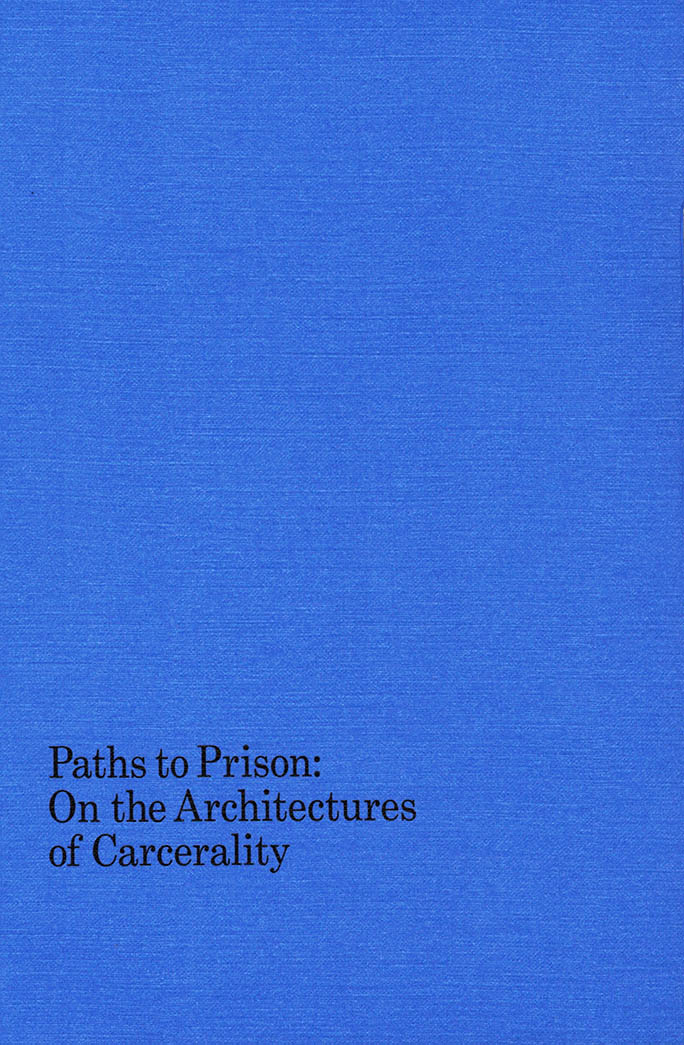
Columbia Books on Architecture and the City
Paths to Prison: On the Architectures of Carcerality
As Angela Y. Davis has proposed, the "path to prison," which so disproportionately affects communities of color, is most acutely guided by the conditions of daily life. Architecture, then, as fundamental to shaping these conditions of civil existence, must be interrogated for its involvement along this diffuse and mobile path. Paths to Prison: On the Architectures of Carcerality aims to expand the ways the built environment's relationship to and participation in the carceral state is understood in architecture. The collected essays in this book implicate architecture in the more longstanding and pervasive legacies of racialized coercion in the United States—and follow the premise that to understand how the prison enacts its violence in the present one must shift the epistemological frame elsewhere: to places, discourses, and narratives assumed to be outside of the sphere of incarceration.
Paths to Prison: On the Architectures of Carcerality offers not a fixed or inexorable account of how things are but rather a set of starting points and methodologies for reevaluating the architecture of carceral society and for undoing it altogether.
With contributions by Adrienne Brown, Stephen Dillon, Jarrett M. Drake, Sable Elyse Smith, James Graham, Leslie Lodwick, Dylan Rodríguez, Anne Spice, Brett Story, Jasmine Syedullah, Mabel O. Wilson, and Wendy L. Wright.
Published September 2020

The Tiniest Muzzle Sings Songs of Freedom
Taking readers from suburban carports to wintry Russian novels, from summer tomato gardens to the sublime interiors of presleep thoughts, Magdalena Zurawski's poems anchor the complexities of our interconnected world in the singularity of the human experience. Balancing artistic experimentation with earnest expression, achingly real detail with dazzling prismatic abstraction, humor with frustration, light with dark, she offers a book of great human depth that is to be carried around, opened to anywhere, and encountered.
Magdalena Zurawski is the author of the novel The Bruise, which won the Ronald Sukenick Award from FC2 in 2008 and a LAMBDA literary award in 2009, and the collection of poems Companion Animal, which was published by Litmus Press in 2015 and won a Norma Faber First Book Award from the Poetry Society of America. She attended Brown University where she studied with poets Rosmarie and Keith Waldrop, C.D. Wright, and Peter Gizzi. She has lived in Berlin, New York, Philadelphia, San Francisco, and Durham, NC where she ran the Minor American Reading Series. She is currently Assistant Professor of English and Creative Writing at the University of Georgia.
Published April 2019

Sonnet(s)
A lost gem of permutational conceptualism from a key figure in artist's book culture, available again
Known internationally as one of Mexico's most important conceptual artists, Ulises Carrión (1941-89) played a decisive role in defining and conceptualizing the genre of the artists' book through his manifesto, The New Art of Making Books (1975), which he wrote soon after the 1972 publication of SONNET(S) and his move from Mexico City to Amsterdam, where he opened the legendary bookshop gallery, Other Books and So, the first space dedicated exclusively to artists' publications and an important precursor to such artists' book hubs as Printed Matter.
One of Carrión's earliest bookworks, SONNET(S) represents a landmark shift in the artist's output from poetry to artists' books. Here, Carrión takes a single poem by Dante Gabriel Rossetti through 50 typographic and procedural permutations. This republication is supplemented by new essays on Carrión's bookworks by contemporary artists, writers, and scholars from Mexico, Europe and the US.
Published March 2021

Andrei Monastyrski: Elementary Poetry
Russian poet, author, artist and art theorist Andrei Monastyrski (born 1949) is, along with Ilya Kabakov, one of the founders of conceptualism in Russia, and a protagonist of Collective Actions, a group of artists who have organized participatory actions on the outskirts of Moscow since 1976. Though his poetry is less well known, poetry is where he began. After writing in the manner of the Russian modernists (who were newly available to Soviet readers during Khrushchev's thaw), Monastyrski's interest in John Cage and ideas about consciousness from Western and Eastern philosophical traditions led him to conduct experiments with sound, form and the creation of artistic situations involving constructed objects that required viewer engagement to complete. Elementary Poetry collects poems, books and action objects from the '70s and '80s, tracing a genealogy of the art action in poetry.
Published Dec 2019

Bite Hard
The first collection by award-winning performance artist/poet Justin Chin. In Bite Hard, Chin explores his identity as an Asian, a gay man, an artist, and a lover. He rails against both his own life experiences and society's limitations and stereotypes with scathing humor, bare-bones honesty, and unblinking detail. Whether addressing "what really goes on in the kitchen of Chinese restaurants" or a series of ex-boyfriends, all named Michael, Chin displays his remarkable emotional range and voice as a poet. His raw, incantatory, stream-of-consciousness poems confront issues of race, desire, and loss with a compelling urgency that reflects his work as in performance, speaking directly to an audience. Throughout this collection, Chin demonstrates his uncanny ability to convey thought-provoking viewpoints on a variety of controversial subjects.

The End
Poet, translator, and educator Aditi Machado’s The End is an essay about the ends of poems and the ends of time. Through close readings of a range of poets and thinkers (including Rainer Maria Rilke, Emily Dickinson, and Lyn Hejinian), an interrogation of the received aesthetics of US writing workshops, and reflections on her own poetic practice, Machado examines notions of epiphany, closure, excess, and economy.
This pamphlet is part of UDP’s 2020 Pamphlet Series: twenty commissioned essays on collective work, translation, performance, pedagogy, poetics, and small press publishing. The pamphlets are available for individual purchase and as a subscription. Each offers a different approach to the pamphlet as a form of working in the present, an engagement at once sustained and ephemeral.
Aditi Machado is the author of Some Beheadings (Nightboat) and the translator of Farid Tali’s Prosopopoeia (Action). Her poetry and criticism also appear in chapbook form as well as in journals like Lana Turner, VOLT, Chicago Review, Western Humanities Review, and Jacket2. Her second poetry collection Emporium (forthcoming) recently received the James Laughlin Award. Machado works as an Assistant Professor at University of Cincinnati.

Letters: The classroom is burning, let's dream about a School of Improper Education
Since its founding as a cultural studies group in 1999 in Yogyakarta, Indonesia, KUNCI Study Forum & Collective has experimented with methods of producing and sharing knowledge through acts of collective study at the intersections of affective, manual, and intellectual labor. This pamphlet is a collaboratively authored epistolary essay that narrates the discourse behind the development of KUNCI’s School of Improper Education, an initiative that posits studying together as a tactical approach to creating the conditions for social movement. Founded in 2016, The School of Improper Education is an avenue through which unlearning can be practiced, where unknowingness can be transformed into a series of productive tools for understanding the contemporary social ecosystem and articulating the resourcefulness of an independent art and cultural organization.
This pamphlet is part of UDP’s 2020 Pamphlet Series: twenty commissioned essays on collective work, translation, performance, pedagogy, poetics, and small press publishing. The pamphlets are available for individual purchase and as a subscription. Each offers a different approach to the pamphlet as a form of working in the present, an engagement at once sustained and ephemeral.
KUNCI Study Forum & Collective experiments with methods of producing and sharing knowledge through acts of studying together at the intersections between affective, manual, and intellectual labor. Since its founding in 1999 in Yogyakarta, Indonesia, KUNCI has been continuously transforming its structure, ways, and medium of working. Initially formed as a cultural studies study group, at present KUNCI’s practices emphasize collectivizing study by way of space-making, discussion, research, publishing, and school-organizing. KUNCI traverses and connects institutional, disciplinary, and geographical boundaries. KUNCI’S membership is informal and based on friendship, as well as principles of self-organization and collaboration.
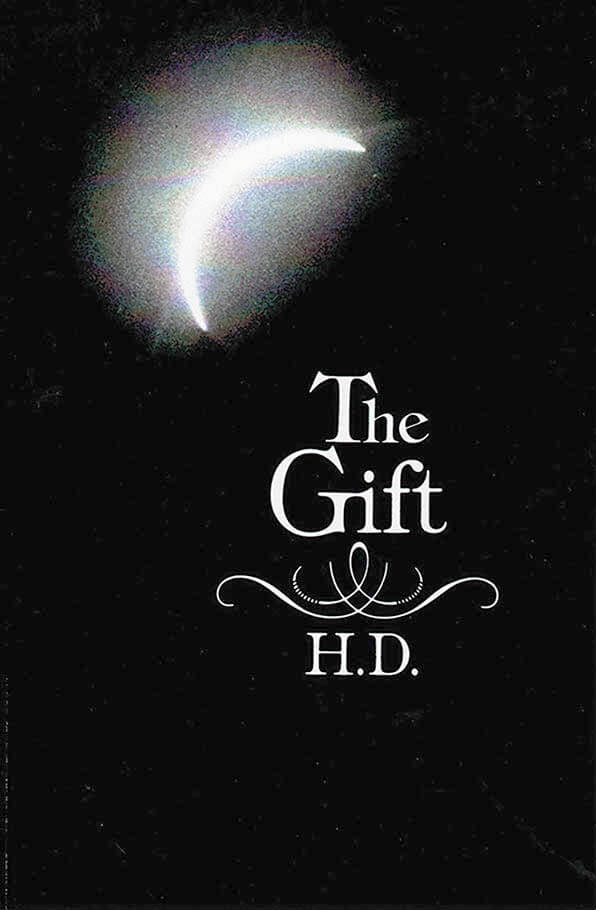
The Gift
The connections and interconnections of past and present––the realization that life is a whole continuously echoing back to the past and unfolding toward the future––were sources of the strength, renewal, and joy celebrated in H.D.’s Trilogy and, in a differing, but no less real way, in The Gift––her novelistic memoir of childhood. In recapturing her memories of being a very little girl in Bethlehem, Pennsylvania, and later on a country place outside Philadelphia, H.D. “let the story tell itself or the child tell it.” It is this voice or child’s-eye view that lends The Gift its special charm as H.D. recreates the ordinary and extraordinary occasions of her early youth, the nightmares and delights. A road-company presentation of Uncle Tom’s Cabin, Christmas Eve with its particular family ritual, a family outing, a disturbing accident––the happenings and incidents, perceptions and misconceptions with which a child’s life is crowded are the substance of this most winning book. As she did for the H.D. novel HERmione, H.D.’s daughter, Perdita Schaffner, provides a fine introduction.

Translation is a Mode = Translation is an Anti-neocolonial Mode
Don Mee Choi is the author of three books of poetry and hybrid essays, and an award-winning translator of contemporary Korean women’s poetry. In this pamphlet, Translation is a Mode=Translation is an Anti-neocolonial Mode, she explores translation and language in the context of US imperialism—through the eyes of a “foreigner;” a translator; a child in Timoka, the made-up city of Ingmar Bergman’s The Silence; a child from a neocolony.
This pamphlet is part of UDP’s 2020 Pamphlet Series: twenty commissioned essays on collective work, translation, performance, pedagogy, poetics, and small press publishing. Each offers a different approach to the pamphlet as a form of working in the present, an engagement at once sustained and ephemeral.
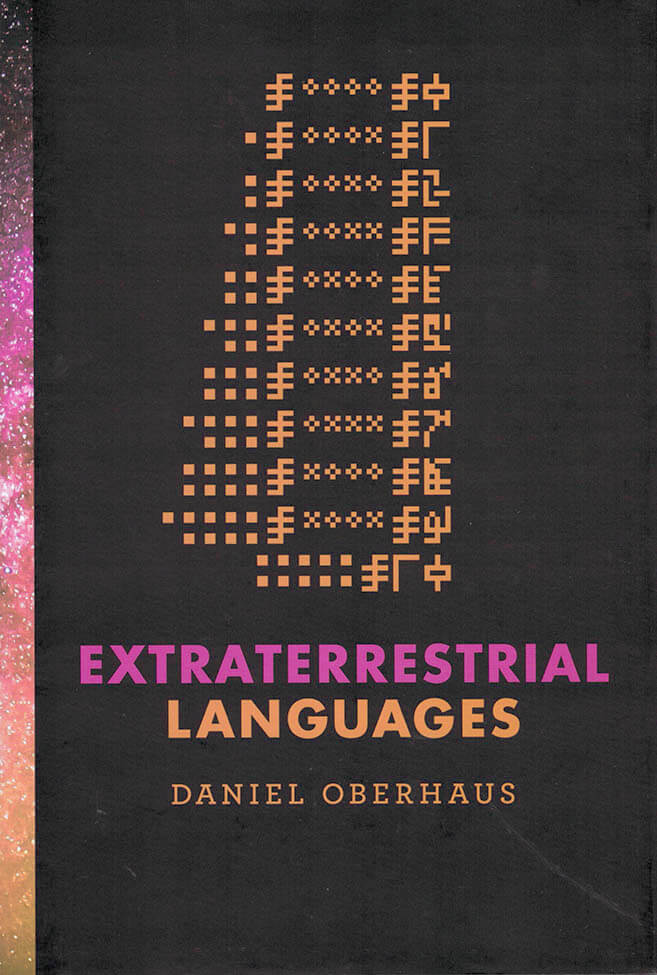
Extraterrestrial Languages
If we send a message into space, will extraterrestrial beings receive it? Will they understand?
The endlessly fascinating question of whether we are alone in the universe has always been accompanied by another, more complicated one: if there is extraterrestrial life, how would we communicate with it? In this book, Daniel Oberhaus leads readers on a quest for extraterrestrial communication. Exploring Earthlings' various attempts to reach out to non-Earthlings over the centuries, he poses some not entirely answerable questions: If we send a message into space, will extraterrestrial beings receive it? Will they understand? What languages will they (and we) speak? Is there not only a universal grammar (as Noam Chomsky has posited), but also a grammar of the universe?
Oberhaus describes, among other things, a late-nineteenth-century idea to communicate with Martians via Morse code and mirrors; the emergence in the twentieth century of SETI (the search for extraterrestrial intelligence), CETI (communication with extraterrestrial intelligence), and finally METI (messaging extraterrestrial intelligence); the one-way space voyage of Ella, an artificial intelligence agent that can play cards, tell fortunes, and recite poetry; and the launching of a theremin concert for aliens. He considers media used in attempts at extraterrestrial communication, from microwave systems to plaques on spacecrafts to formal logic, and discusses attempts to formulate a language for our message, including the Astraglossa and two generations of Lincos (lingua cosmica).
The chosen medium for interstellar communication reveals much about the technological sophistication of the civilization that sends it, Oberhaus observes, but even more interesting is the information embedded in the message itself. In Extraterrestrial Languages, he considers how philosophy, linguistics, mathematics, science, and art have informed the design or limited the effectiveness of our interstellar messaging.

Inflamed Invisible
A rich collection of essays tracing the relationship between art and sound.
In the 1970s David Toop became preoccupied with the possibility that music was no longer bounded by formalities of audience: the clapping, the booing, the short attention span, the demand for instant gratification. Considering sound and listening as foundational practices in themselves leads music into a thrilling new territory: stretched time, wilderness, video monitors, singing sculptures, weather, meditations, vibration and the interior resonance of objects, interspecies communications, instructional texts, silent actions, and performance art.
Toop sought to document the originality and unfamiliarity of this work from his perspective as a practitioner and writer. The challenge was to do so without being drawn back into the domain of music while still acknowledging the vitality and hybridity of twentieth-century musics as they moved toward art galleries, museums, and site-specificity. Toop focused on practitioners, whose stories are as compelling as the theoretical and abstract implications of their works.
Inflamed Invisible collects more than four decades of David Toop's essays, reviews, interviews, and experimental texts, drawing us into the company of artists and their concerns, not forgetting the quieter, unsung voices. The volume is an offering, an exploration of strata of sound that are the crossing points of sensory, intellectual, and philosophical preoccupations, layers through which objects, thoughts and air itself come alive as the inflamed invisible.

Jupiter: Andreas Sell ‘Life Performance’
Jupiter is the monograph of the artist Andreas Sell by the curator Joel Mu and the outcome of their collaboration. It includes a selection of Andreas’ work of the last fifteen years, an essay in five parts by Joel and a poem by Alice Heyward. Andreas’ work often coincides with his life story, composing both a material and immaterial narration. Joel shares biographical and autobiographical stories in his writing about Andreas’ work. The narratives intertwine.
Personal experiences, memories and relationships take shape with matter, images and words trying to make sense of the world—its social conditions and politics, other people and life itself.
Jupiter is about Andreas Sell’s ‘Life Performance’ as the title of the book suggests; it explores life performance from the constant position of a foreigner, from a viewpoint on the side. Andreas and Joel reflect on identities and challenge categorization; they seek for a more inclusive sense of belonging and defend the multiplicity of oneness. Jupiter also defies categorization; it is a monograph, but also a biography, an autobiography, a catalogue, an artist book, a diary, a collective work on one person’s work. — Text by Galini Noti
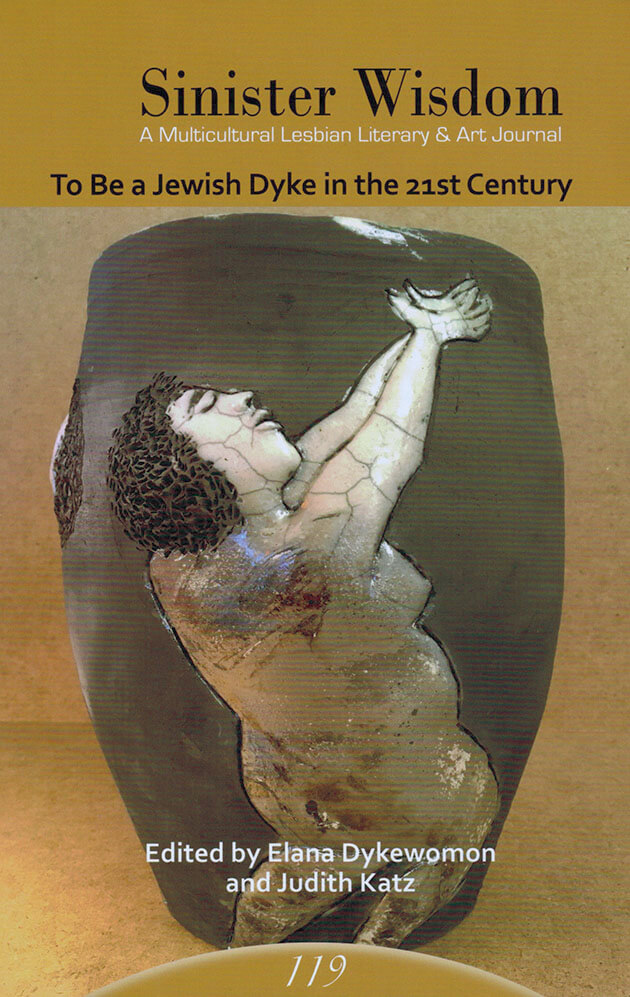
To Be a Jewish Dyke in the 21st Century
What are Jewish lesbians thinking about? Writing about? Making art about now, here in the first two decades of the 21st Century? Do we see ourselves as Jewish dykes? Jewish lesbians? Genderqueer Jews? How are we thinking about our Jewish lesbian communities and families, natal or invented? How have our relationships to the states of Israel and Palestine changed over time? Can we reconcile the contradictions between our faiths and our politics? Our gender and racial identities? How do we envision our futures and reimagine our pasts, especially in these fractious and dangerous times? One thing is certain. Our commitments to making trouble and speaking up are strong.
This issue of Sinister Wisdom: To Be a Jewish Dyke in the 21st Century, which takes its title from that life-giving stanza in Muriel Rukeyser’s epic poem “letter to the Front”, is a gathering of answers, challenges, and opinions directed at these and other questions.
Featuring work by
Yael Mishali
JEB (Joan E. Biren)
Terry Baum
Joan Larkin
Susan Sherman
Clare Kinberg
Irena Klepfisz
Nancy K Bereano
Penny Rosenwasser
Bonnie Morris
Jyl Lynn Felman
Marla Brettschneider
And more!
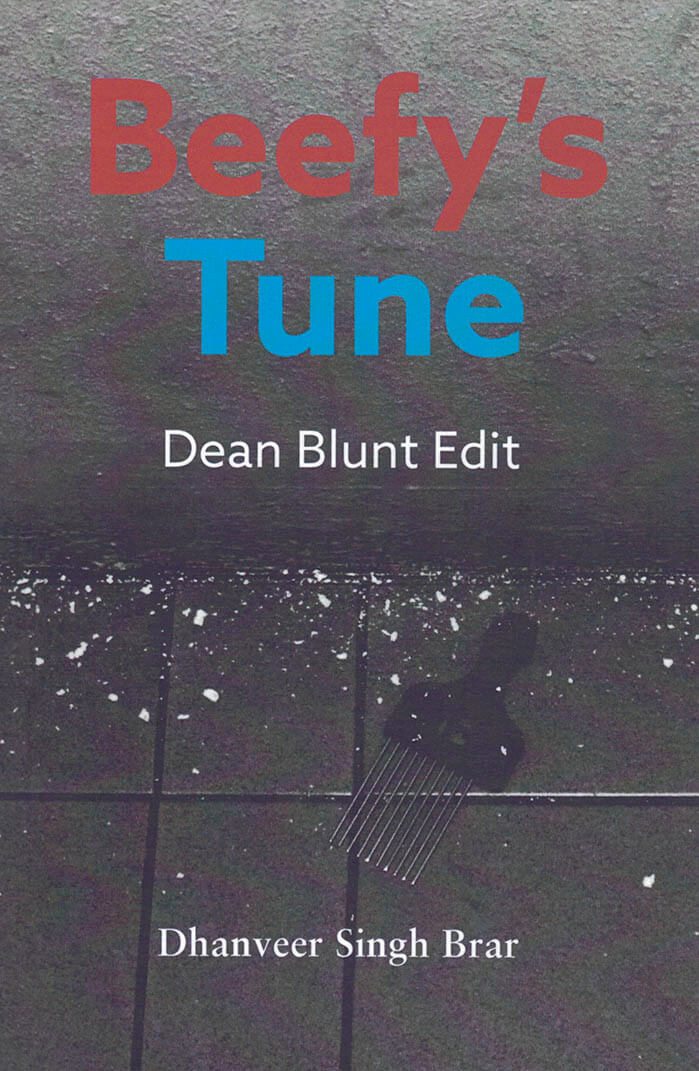
Beefy's Tune (Dean Blunt Edit)
Dean Blunt is one of the most important British artist of the current century because he fundamentally does not care about Britain. His importance makes it shocking that such little critical attention has been paid to his work. His indifference explains it.
Dhanveer Singh Brar’s ‘Beefy’s Tune (Dean Blunt Edit)’ looks to initiate a conversation that needs to be had about Dean Blunt, about Britain (through Blunt’s indifference to it), and about Blackness in Britain (through the depth and complexity of Blunt’s feeling for it). Using the 2016 album ‘BBF Hosted By DJ Escrow’ as a means of navigation, Brar hears Blunt in order to access the long contested dream of Britain’s disappearance that was conducted under the name of Black British Arts. Partial (in the sense of his relation to Blunt) and partial (in the sense of unfinished), ‘Beefy’s Tune (Dean Blunt Edit)’ see’s Dhanveer Singh Brar give the dream a grammar, if not a name.
Dhanveer Singh Brar is a theorist and scholar who teaches in the Department of Visual Cultures at Goldsmiths, University of London. His is a member of Le Mardi Gras Listening Collective and Lovers Discourse. Brar’s second book ‘Teklife, Ghettoville, Eski: The Sonic Ecologies of Black Music in the Early Twenty-First Century’ will be published by Goldsmiths Press/MIT Press in Spring 2021
"To encounter BBF Hosted by DJ Escrow through Dhanveer Brar’s ears is to see Babylon through his eyes, and to sense Britain—to uncover with 'accuracy, brutality and beauty' the complexities of its meaning—through the social music, social vision and social feel of those who refuse the Britishness that is withheld from them. Brar discerns Dean Blunt’s rightful place in a cultural field where critical discourse and sonic dream are fundaments of a dub university curriculum whose various approaches show the absolute necessity and generativity of stealth, flaw and the resistance to category. Blunt’s “love letter to the blackness of Hackney” deserves the most rigorous, gentle, erudite attention. Happily, Dhanveer Brar is here to provide it." – Fred Moten.

More-than-Human
Lucia Pietroiusti, Marina Otero Verzier and 1 more
The More-than-Human reader brings together texts that reflect on the state of post-anthropocentric thinking today, by writers from a wide range of disciplines. Focusing on the ecologies and technologies of climate injustice and inequalities, as well as the destructive structures lurking within anthropocentrism, More-than-Human proposes complex entanglements, frictions, and reparative attention across species and beings.
Thinking past the centrality of the human subject, the texts that compose this reader begin to imagine networks of ethics and responsibility emerging not from the ideologies of old, but from the messy and complex liveliness around and beneath us.
Rather than attempting to be a comprehensive compendium on the topic (which would be virtually impossible), More-than-Human provides a cross-section of the breadth and vitality of a literary, scientific, and conceptual milieu where multiple strands of work intersect even as they are frequently regarded as belonging to separate disciplinary discourses.
Contributors: Stacy Alaimo, Ramon Amaro, Karen Barad, Rosi Braidotti, Octavia Butler, Georges Canguilhem, Marisol de la Cadena, NASA History Department, Silvia Federici, Scott F. Gilbert, Édouard Glissant, Jack Halberstam, Donna Haraway, Myra J. Hird, Kristina Lyons, Patricia MacCormack, John T. Maher, Michael Marder, Timothy Mitchell, Reza Negarastani, Jussi Parikka, Elizabeth Povinelli, Paul B. Preciado, María Puig de la Bellacasa, Filipa Ramos, Isabelle Stengers, Elly R. Truitt, Anna L. Tsing, Eduardo Vivieros de Castro, Jason Wallin, Kathryn Yusoff and Joanna Zylinska.
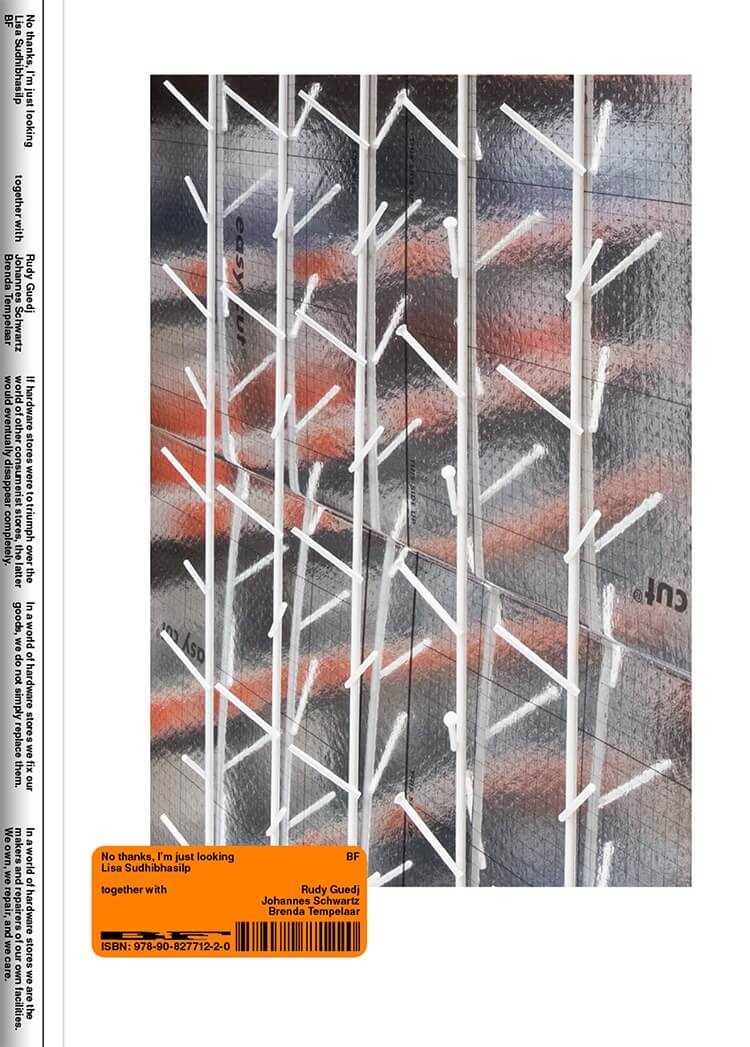
No thanks, I’m just looking
Born out of her fascination for shop displays, Lisa Sudhibhasilp imagined an exhibition in a hardware store. Improvising a series of sculptural interventions in situ, the artist played with existing display structures, proposing the hardware store as a place where the display of materiality can be contemplated like works of art in exhibition spaces. Photographer Johannes Schwartz documented the artist’s ephemeral installations and the existing fixtures and fittings, creating a portrait of the store. Accompanying the visual journey, a series of texts written by Sudhibhasilp, illustrated by Rudy Guedj, provides insight into her research through anecdotal stories and other miscellaneous facts on materials and exhibition design. Shifting between the form of the artist book and the exhibition catalogue “No thanks, I’m just looking” stands as the sole remaining document of the event.

Bottle Joe
During their residency at Est-Nord-Est in Saint-Port-Joli, Quebec, Elvia Teotski and Jérémy Laffon stumble upon a small shed that seems inhabited but find no trace of its resident Bottle Joe. The artists start to investigate the building and create a series of sculptural yet functional wooden prostheses for its abandoned furniture. Through a drunk photographic journey and a series texts written from the perspective of the mysterious Joe, the publication keeps on zooming in and out of the building and its surrounding environment to account of the temporary monumentalisation of the place and its former inhabitant.

A Loose Thread of Red
The first book in a series of four explores a connection between images taken as part of a larger series in Japan over one summer and one winter. Each book has been lovingly hand-constructed.
The presence of self doubt is deeply felt when trying to compile a collection of photographs that have endured an endless process of revision and recompilation.
Scouring every inch of each image to find microscopic relations between subject, composition and colour until eventually something shifts and that 'everything in its right place' feeling soothes the throbbing head.
It's not an easy thing to articulate. It's a sort of subterranean relationship between each frame, as if a mysterious past or conspiracy that links everything together is identified, but still not understood.
It's as if the book always intended to exist and that you had been entrusted with the task of giving it life. (As you had possibly already done before?)
There's a certain term of phrase for someone who does the same thing repeatedly and expects different results.
So what is it to the person who stares at the same collection of images over and over and starts to see something different?
After such intense scrutiny nearly all memory associated with the photograph deteriorates. All that remains are hazy fragments of the original memories that seem like they're trying to tell you something but can't quite remember what it was.
And sandwiched around those memories are the new ideas that you've completely made up to talk yourself into sending this all off to the printers and moving on with your life.
Poetry has never been my strong suit, all attempts to metaphorically circumvent feeling or intention merely end up being interpreted as either the metaphor itself or something else entirely.
So perhaps we can sum this up very simply.
This is a book about red things.
Red has a way of implying a behind the scenes existence, a warning, distance, communication.
Or maybe, just overdue.
19 pages, 26.9 x 19 cm, softcover, Out of Office (Melbourne)
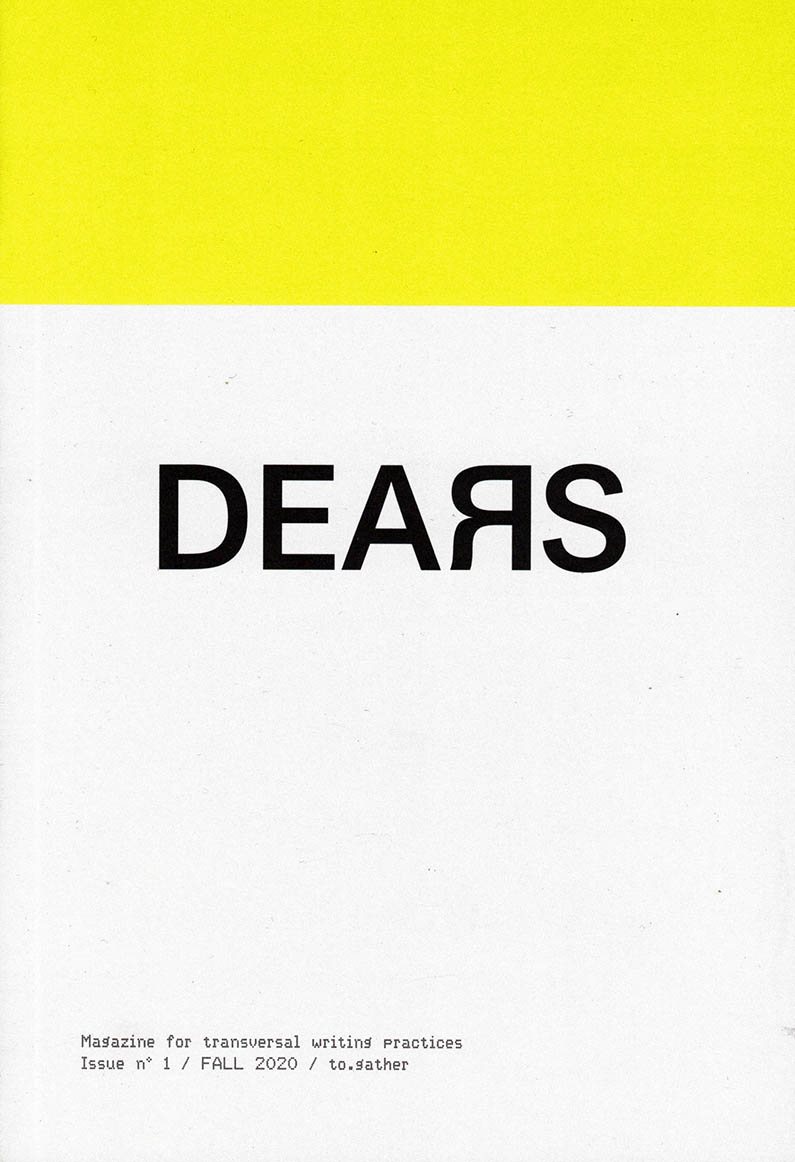
DEARS No. 1 TO.GATHER
Delphine Chapuis-Schmitz, Robert Steinberger and 1 more
DEARS Magazine on transversal writing, with texts by Season Butler, Crystal Z Campbell, Nicole Bachmann, Alessandro De Francesco, Benjamin Egger, Florinda Fusco, Gilles Furtwängler, Donna J. Haraway, Serafina Ndlovu, Rose Rand and Riikka Tauriainen.

The Little Black Book of Grisélidis Réal: Days and Nights of an Anarchist Whore
The Little Black Book of Grisélidis Réal is the portrait of a true humanist who made a career out of compassion. Hailed as a virtuoso writer and a "revolutionary whore," Grisélidis Réal (1929-2005) chanced into prostitution at thirty-one after an upper-class upbringing in Switzerland. Serving clients from all walks of life, Réal applied the anarcho-Marxist dictum "from each according to his abilities, to each according to his needs" to her profession, charging sliding-scale fees determined by her client's incomes and complexity of their sexual tastes.
Réal went on to become a militant champion of sexual freedom and prostitutes' rights. She has described prostitution as "an art, and a humanist science," noting that "the only authentic prostitution is that mastered by great technical artists...who practice this form of native craft with intelligence, respect, imagination, heart..."
This volume includes lengthy dialogues from 1979-1981 with Réal conducted by journalist and author Jean-Luc Henning, in which she eloquently discusses the theoretical implications of sex-positive whoring and relates her experiences both inside and outside the profession: from her lengthy love affair with the "Berber" to such "psychological" and "special" clients as the "moldy rhinoceros."
The "Little Black Book" that rounds out this book is drawn from the logs in which Réal kept track of her many clients, from "Pedro, hilarious fat Spaniard, devoted, simple, honest, fat peasant face, 70F" to "Pierre 8 (from Basel), blue eyes, fifties, slightly balding, cultivated, sweet-violent...licks my finger after I remove it from his anus...100-400F." It is a journal that not only chronicles Réal's working life, but offers a clinically direct, investigative sociological analysis of the sexual subcultures of her time.
Translated by Ariana Reines.